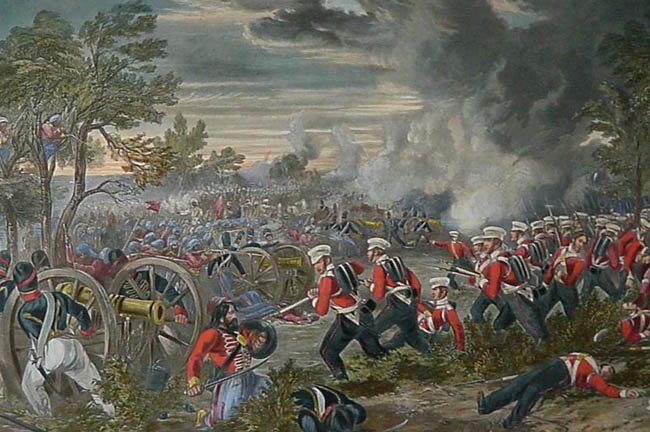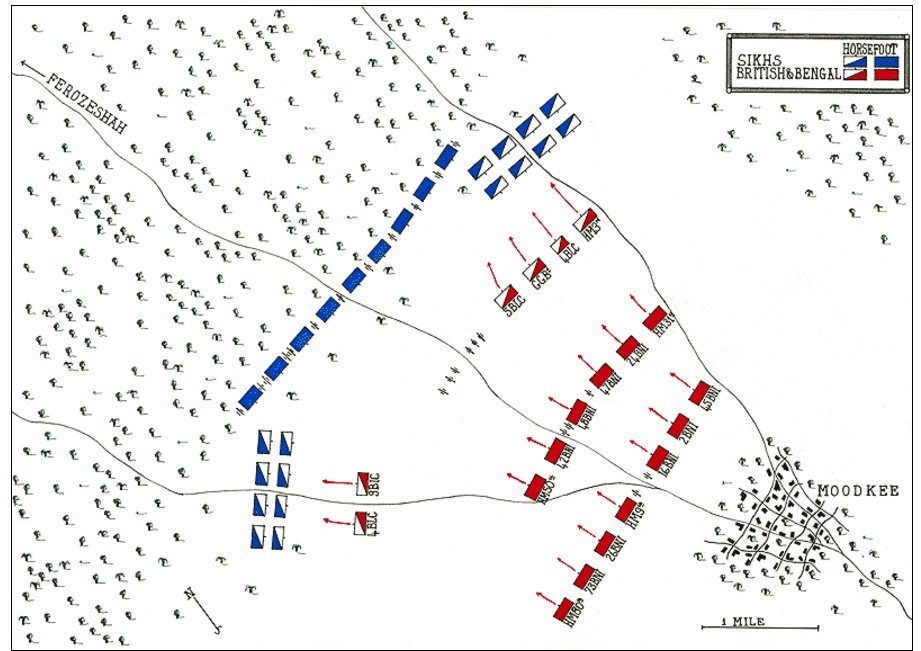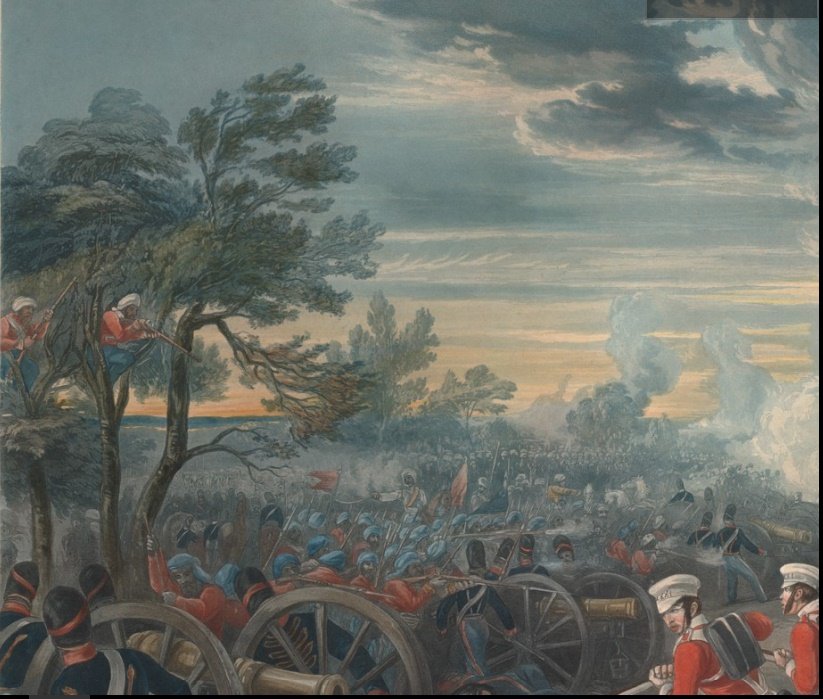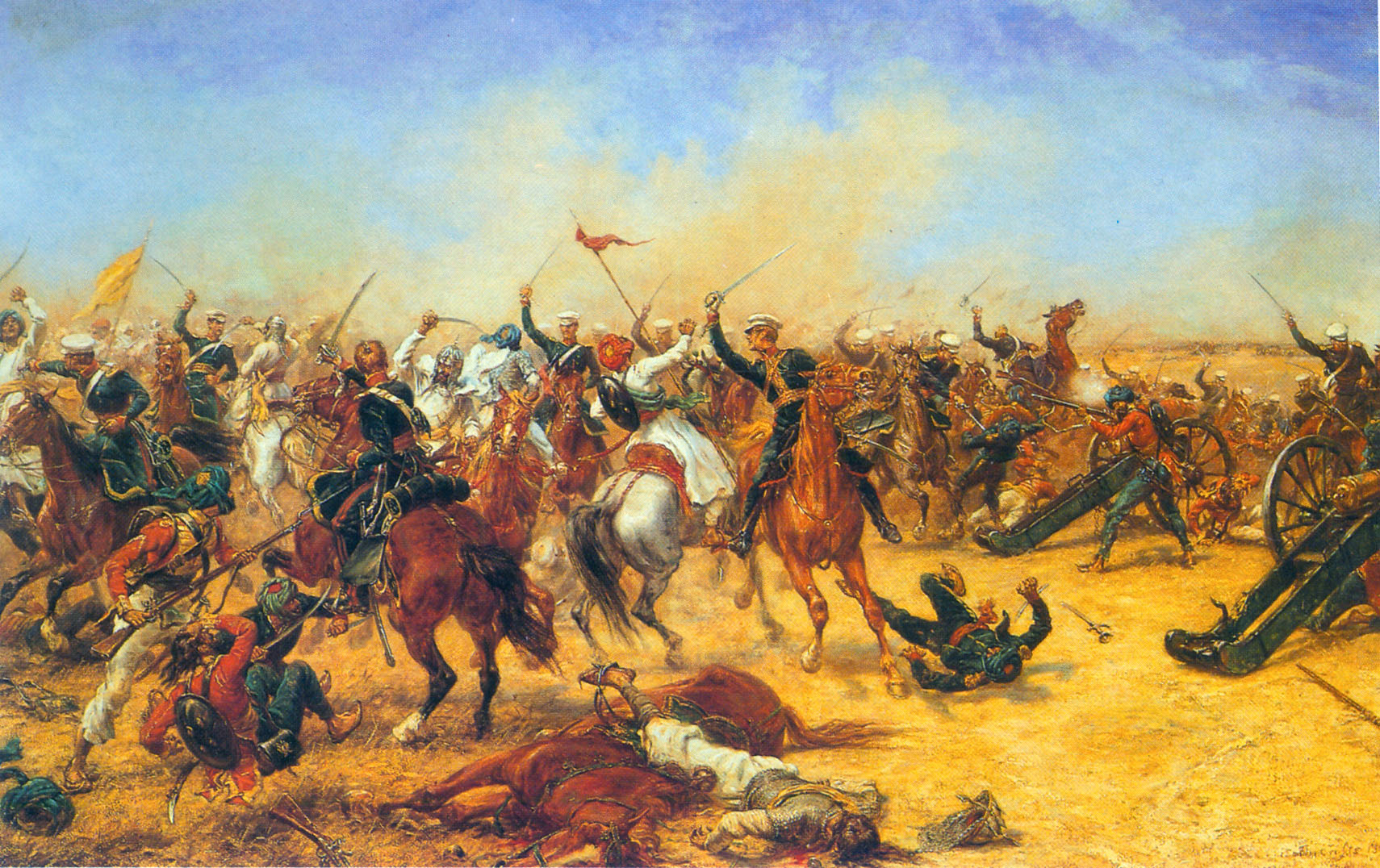
The 31st Regiment, Sir Harry Smith’s Division, advancing to the charge against Sikh artillery battery and massed troops; snipers perched in trees at left. The Battle of Moodke Painting by Henry Martens(1848).
Name of battle: Battle of Mudkee/Moodkee (Mudki)
Date of battle: December 18, 1845
Location: On the south bank of the Sutlej River in the Punjab in North West India.
Generals that fought in the battle: Major Gen Sir Hugh Gough and Gen Sir Henry Hardinge, Raja Lal Singh and Tej Singh
Description:
The battle at Mudki pitted a number of Sikh generals and commanders against the main British and Bengal Army, under its commander-in-chief, Hugh Gough, which had began marching rapidly from its garrisons at Ambala and Meerut. Under the orders of Tej Singh, Commander in Chief of the Sikh army, Kanh Singh Mann, Shumsher Singh, Chutter Singh, Mewa Singh, Rattan Singh Mann, were to remain at Ferozepore. Primarily to neutralise the limited threat posed by the Major General Littler and his small force of the 27th Native Infantry. However Tej Singh did not order any attack which gave the British a huge advantage later at Ferozeshah. When Littler and his forces came to out the route the Sikhs. Lal Singh retreated much to the chagrin of the Sikh commanders.
Further lack of ambition was exhibited by Tej Singh when he asked Ranjodh Singh Majithia who was stationed at Phillour, Ludhiana to remain static. These forces could have been pivotal to fight at Mudki. Lal Singh essentially kept a defensive position. Bahadur Singh’s Brigade was on the left, Fauj I Khas in the middle, Methtab Singh (right), Ghorchurras (cavalry) was pitched on both sides, with Sikh snipers in the trees.

Army layout at the Battle of Mudki. Courtesy of British Battles.
Both armies numbered around 12, 500 give or take. The British had Europeans as one third of the army. In terms of artillery they also had more Guns maybe two to one. Lord Gough was on the right flank, together with Govenor General-Lord Hardinge. Many of the units were under Lt General Harry Smith and he positioned himself on the right flank. Major General Gilbert was in the centre; whilst General John McCaskill commanded another division positioned on the left, Captain George Bidulph (3rd irregular cavalry) was captured by Akali Ganda Singh Nihung at Mudki fort but was later released by Lal Singh who was in camp and not in the battlefield.
General Robert Sale (hero of the Afghan War of 1839), Joseph McCaskill , Brigadier Boulton and two aids of the Governor General being amongst the 215 or so killed and 655 wounded. The 3rd Light Dragoons, (who took the heaviest losses) cavalry charge led to them capturing a Sikh battle standard-their action in battle labelled them the ‘Moodkee Wallahs.’ Whilst the Sikhs had a different label, ‘Shaitan ke Bacchi’ –children of satan. British sources say that the Sikhs gave no quarter-he would usually fight as long as he had a musket.
Major Broadfoot, the political officer approached the British camp and shouted, ‘ the Sikhs are upon us’. The campaign started with Gun bombardment on both sides, with Brigadier Brooks who limbered up his ’12 field battery 9-pounders’ and ’30 horse artillery 6-pounders’. With no sign of leadership on the part of the Sikhs (Lal Singh nowhere to be seen, with some reports saying he was hiding under a bush), the Ghorchurras were dealt with an attack by the Native Cavalry Lancers and the Dragoons which led to their withdrawal. Sikh snipers started firing on the British Cavalry with the jungle helping the Sikh line of defence led to the British withdrawal.
The Sikh attack was sustained by the Muslim gunners and Sikh infantry. Leading to hand to hand combat between both forces, the Sikhs sustained heavy losses due to this direct action. The Akali Nihangs or night-errants of Guru Gobind Singh were notable in these encounters. The 31st division sustained heavy losses with Brigadier Bolton being killed and their colour regiment dropping their colours. The British became detached from their own regiments and confusion was paramount. In the melee, C in C Gough, took over and directed the charge at the Sikh guns. Most of the Muslim gunners and infantry fell in this charge.

Sikh Snipers on top left who were effective against the British.
Essentially the British managed to capture many of the Sikh guns after many hours of fighting. The Sikhs retreated to Ferozeshah whilst the British retreated to within Mudki with Sikh snipers still firing at them. The battle was in no way a win for either side, according to Cook, ‘thus ended one of the most untidy actions the British Army in India had ever fought.’ Treachery and inaction on the part of Lal Singh and Tej Singh had saved the day for the British.

The 3rd Light Dragoons at the Battle of Mudki, 1845 by Ernest Croft
Key points:
Had Lal Singh attacked Littler who was stationed at Ferozepore with is small force there would have been a different outcome. About this incident, J. D Cunningham says, “The object, indeed, of Lal Singh and Tej Singh was not to compromise themselves with the English by destroying an isolated division, (at Ferozepur) but to get their own troops dispersed by the converging forces of their opponents.
The British were not rested after travelling many miles to Mudki, tired and hungry they were hurriedly deployed into battle. Harry Smith would criticise the tactics of Gough, stating that the British should have waited for the Sikhs to come out the jungle where they would have had open space to attack the Sikhs.
There were also other international witnesses to the events at Mudki and as result Dr Werner Hoffmeister and Prince Waldemaar were to give visual and verbal accounts to the fighting take place at Mudki.
Losses:
Gough’s army of British and Bengal Native regiments suffered 872 killed and wounded in the battle. The predominant role played by four of the British regiments in the fighting is reflected in their casualties (414 in total):
HM 3rd King’s Own Light Dragoons suffered 61 killed and 35 wounded from a strength of 497, with 105 horses killed and 23 injured.
HM 9th Foot suffered 52 casualties.
HM 31st Foot suffered 157 casualties.
HM 50th Foot suffered 109 casualties.
42nd BNI suffered 89 casualties.
The British lost two generals: Sir John McCaskill and Sir Robert Sale
Sikh casualties are not known but may have been substantial. They lost 17 guns.
Further reading
Anglo Sikh Wars-Karnail Singh
The Last Sunset-The Rise and Fall of the Lahore Durbar-Capt Amarinder Singh
The First Anglo-Sikh War-Amarpal Singh Sidhu
The Sikh Wars 1845-1846 1848-1849-Hugh Cook
History of the Sikhs-J.D Cunningham
